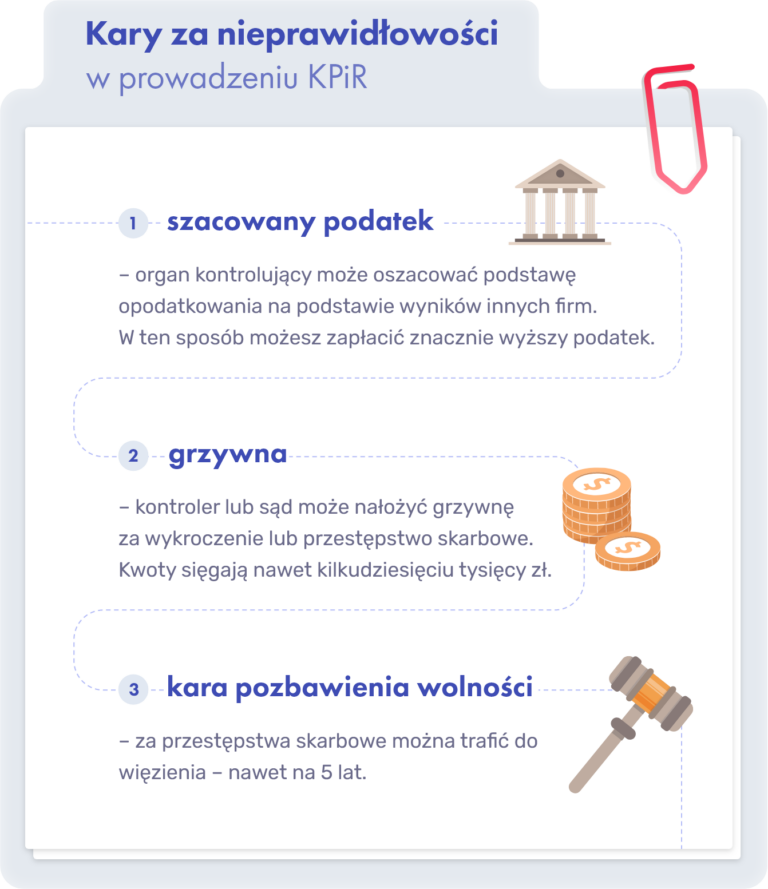KPiR – what is it?
As the name implies, the Income and Expense Ledger is used to record the company’s income earned and expenses incurred (business expenses). The KPiR is, in fact, a simplified form of record-keeping – available only to entrepreneurs whose revenues from sales do not exceed a net amount of €2 million per year.
Important!
Companies that exceed the indicated threshold are required to maintain full accounting. This means that even a one-time excess of the revenue amount obliges the company to establish full accounting. If revenues in the following year fall below the €2 million limit, the company can return to accounting using the Income and Expense Ledger.
Limit of KPiR – how to calculate it?
To verify that in order for your company not to exceed the 2 million euro revenue limit, a specific exchange rate must be included in the calculation. In this case, the average exchange rate of the National Bank of Poland from the first working day of October of the previous year is used. This means that in 2025 the revenue limit is PLN 9,218,200 (at an exchange rate of 4.6091).
Important!
As of January 2026, the income limit for eligibility to use the P&C will increase. Entrepreneurs will be able to use a revenue and expense ledger until they earn revenues of less than €2.5 million.
In 2026, the revenue limit will be PLN 10,646,500 (at an exchange rate of 4.2586).
From the moment the company’s revenues exceed the limit set for the year, the company is required to switch to full books. The opportunity to return to the simplified version of accounting will only reappear at the beginning of the next fiscal year, as long as the company’s revenues did not exceed the limit in the previous one.
What data do we enter in the Income and Expense Ledger?
The P&L must contain information on all accounting evidence and business events – in other words, it is necessary to document in detail every company purchase and sale.
KPiR includes:
- address details of the company and its name;
- TIN and REGON of the company;
- The title “Tax Income and Expense Ledger” with the month and year on each page;
- record table.
It is the latter element that will receive the most attention. The table of records must be structured in a specific way – so that all relevant data on company sales and purchases are included.
Items in the inventory table are described with the following data:
- ordinal number;
- date of economic event;
- accounting receipt number;
- Counterparty data (name or company name, address);
- A description of the business event (e.g., payment for accounting services, installment of a company loan or sale of goods);
- Revenue (value of services sold, other revenue, total amount);
- information on purchased commercial goods and materials;
- costs (the amount spent on salaries, purchase invoice expenses, etc.);
- data on research and development costs, included in Art. 26e of the Personal Income Tax Law.
Important!
The number, arrangement and content of the columns in the Income and Expense Ledger are determined by the Finance Minister’s regulation on maintaining the P&L – so it is not possible to maintain the Ledger in any other way.
Click to read the current Ordinance (until December 31, 2025)!
Click to read the draft MF Ordinance, which will take effect on January 1, 2026)!
The Income and Expense Ledger will only be allowed to be kept in traditional form until the end of 2025. For obvious reasons, the use of computer programs for bookkeeping is much more popular, but it is worth knowing that the written form is allowed and functions in law as an equivalent to the electronic form only for a very limited time.
The P&L in 2026 – a list of changes.
Starting in January 2026, the Tax Income and Expense Ledger will undergo very significant changes. The Ministry of Finance has published a draft regulation to replace the current one (from 2019). The new document introduces a number of modifications to the current form of PKPiR, and will affect almost all taxpayers – with minor exceptions.
We have compiled a complete list of changes for our readers – there are as many as fifteen.
1. no more traditional Income and Expense Ledger – from 2026 only electronic
Beginning in January 2026, a company’s P&L will only be able to be kept in electronic form, and through applications (computer programs) designed for this purpose. This means that paper ledgers or those kept in spreadsheets will become a thing of the past.
§ Section 3(3) of the new regulation, however, indicates two exceptions. Books may be kept without the use of programs if separate regulations exempt or exempt such an obligation. This includes:
- clergy who opted out of the lump sum,
- persons acting under agency contracts or contracts on commission terms.
2. farmers will not benefit from the simplified formula
The new regulations do not mention a simplified template for the PCR. Such a solution has so far been provided for farmers:
- operating a farm without hiring employees,
- members of agricultural production cooperatives,
- agricultural workers, doing business personally or with family members in a joint household,
- With an income of no more than PLN 10,000 per year.
As of 2026, this solution will cease to exist, and every farmer will be required to use a unified PKPiR template.
3. no duplicate statutory definitions
This is a minor change, under which the regulation will not repeat definitions already present in other legislation. Thus, the explanation of concepts such as income, fixed assets and intangible assets has disappeared from the document.
Instead, the definition of an accounting office has changed (it can be found in § 2 item 5 of the new regulation), and in items. 6 and 7 the definitions of the Personal Income Tax Law and the VAT Law have appeared.
4. the regulation cannot be abandoned
Taxpayers will no longer apply for an exemption from the regulation under special circumstances. In the new version of the regulations, this possibility has been removed. Exemptions granted before January 1, 2026 will remain in effect.
5. missing part of regulation for VAT-exempt taxpayers
The new regulation does not include regulations on the use of sales records kept for the ledger by VAT-exempt taxpayers who do not keep sales records.
The provisions contained in Section 7(4) of the previous regulation were removed not for lack of reasonableness, but because they are beyond the scope of the regulation, as the authors make clear in point. 5 of the Explanatory Memorandum.
6. no place to store the ledger and accounting evidence
The new iteration of the regulation does not indicate a specific place where books and accounting evidence should be kept, leaving taxpayers with the recommendation to follow Article 86 of the Tax Ordinance Law.
7. lack of separate books for multi-plant enterprises
Until now, multi-plant enterprises were required to keep a P&L for each plant separately. The new regulation abolishes this obligation, and with it the need to prepare evidence of transfers.
8. exclusion of daily statements of evidence
The catalog of accounting evidence will no longer include daily statements of evidence. Since the new regulation comes into effect, taxpayers will not have to show invoices in a separate statement – they will do so directly in the ledger.
With this change, it will be possible to effectively use JPK_PKPiR structures.
9. exclusion of the possibility of documenting purchases with receipts without a TIN
Certain company purchases made at retail units must be documented using a simplified invoice (receipt with TIN) starting in January 2026. There is an exception to this rule: purchases of fuel and oils made abroad will still be able to be documented with receipts, but only in paper form.
10. unification of deadlines for book entries
All entries in the ledger – both expenses and income – will be made no later than the 20th of each month following the month in which the expense was made or the income was received.
11. signature on the physical inventory only of the owner
Another minor change is the abolition of the obligation for the persons preparing the physical inventory to sign it. Starting in 2026, only the signature of the owner of the establishment (and partners, if applicable) will have to appear on the document.
Only the value of the inventory will have to be entered in the book.
12. no conditions for correctness of electronic ledger
The regulation lacked regulations specifying the conditions to which electronic ledgers must conform. These conditions have so far been specified in § 28 of the regulation.
13. changes to the regulations on the storage of certain invoices
Invoices and receipts documenting sales previously recorded using cash registers were covered by regulations related to storage. The new regulation abandons these regulations, pointing to the VAT law’s resolution of the issue.
14. changes in the correction of data from fiscal reports
If data from fiscal reports (daily or periodic) need to be corrected, the correction should be made on the basis of an internal proof. In the previous version of the regulations, the corrections had to be described on the back of the fiscal report.
15. new columns in the KPiR template
The appendix to the new regulation announces the addition of new columns to the income and expense ledger template:
- Column No. 3 will contain the number identifying the invoice issued using KSeF,
- Column No. 5 will contain the tax ID of the contractor.
Accounting evidence, or what do we enter in the P&L?
The most essential element of the Income and Expense Ledger is the accounting evidence, which is the basis for recording company sales and expenses.
Accounting evidence for the most part is VAT, VAT RR invoices and receipts. Other types of documents are also considered accounting evidence if they certify the fact of an economic operation. These include:
- proofs of postage;
- evidence of bank fees;
- evidence of transfers;
- other evidence of fees;
- daily statements of evidence;
- accounting notes (created to correct entries for business operations resulting from evidence, received from the contractor or provided to the contractor);
- fiscal reports;
- descriptions or specifications of goods and materials (only in conjunction with invoices);
- internal evidence.
Important!
These documents can be considered accounting evidence only if they are described in detail, i.e. include an indication of the parties to the economic operation, the date of issuance of the evidence and the date or duration of the economic operation, identification of the subject of the operation and its value, signatures of the persons authorized to document the operation, as well as a marking that allows associating the evidence with accounting records.
Obligation to keep a KPiR
As we mentioned in the introduction, the Tax Income and Expense Ledger is one of the most frequently chosen forms of recording business events – general accounting is particularly profitable for small entrepreneurs who do not exceed the 2nd tax threshold (do not earn income at the level of PLN 120,000 gross per year).
However, there are groups that have no choice but to be legally obliged to keep a P&L – regardless of income. They are:
- Individuals earning income from non-agricultural business activities, not taxed on a flat rate,
- civil partnerships,
- general partnerships,
- partnerships.
The designated entities must maintain a P&L at least until their revenues exceed a net amount of €2 million – once this amount is exceeded in a given fiscal year, these entities are required to switch to full accounting. Starting next year, the limit will increase to €2.5 million.
The full text of the regulations governing this situation can be found in Art. 2, para. 2 Accounting Act.
Other duties related to maintaining a P&L.
Other records
Just keeping income and expense books is not enough. Any entity using the P&L should simultaneously keep records of fixed assets and intangible assets, as well as records of sales.
In addition, if one of the company’s fixed assets are cars used exclusively for business purposes, it will be necessary to keep mileage records to deduct 100% of the costs generated by the vehicles.
Cantor operations are also required to keep records of purchases and sales of foreign exchange values.
Important!
Even if your company’s books are kept by an office, you should keep the aforementioned sales records at your place of business. It must include: entry numbers, dates of revenue and the amount of revenue. If your company keeps records on a cash register, sales records are not required.
Census of nature
An important obligation when setting up a business is to take a physical inventory as of the start-up date. This inventory is prepared not only at the time of the company’s incorporation, but also at the end of each fiscal year and at the date of liquidation of the business.
A physical inventory is actually a list of all things purchased before the establishment of the company and related to the business, namely: goods and materials for trade, raw materials, semi-finished goods, shortages and usable waste.
Important!
The physical inventory does not include company assets, fixed assets and equipment belonging to the company. So we don’t enter information about the computers we own, office furniture, software or other equipment.
Even if the company does not have any components as of the start date, it is necessary to take a zero physical inventory. Such an inventory appears as the first item in the P&L, marked with the amount of PLN 0.
Closing the Income and Expense Ledger at the end of the year
Like any ledger, the P&L also has an ending, which entrepreneurs create at the end of the fiscal year. This is done by adding up all the amounts in the ledger – if the company has been adding up each column cumulatively throughout the year, their values at the end of December will at the same time provide a summary of annual income and expenses.
After summarizing the columns, you should value the prepared physical inventory and place its value as the last item of the P&L – already after the summary we described earlier. In a properly completed ledger, the valuation of the physical inventory is the last entry.
When closing the P&L, it is also necessary to calculate income by subtracting the cost of income from income.
Consequences and penalties for unreliable record keeping
Since there is an obligation, there must also be a penalty for non-compliance. This is no different in the case of the income and expense ledger. Depending on the severity of offenses, the legislator has provided for different types of consequences. What can be punished for errors in the P&L?

First: the estimated tax
If the tax authority that performs the audit finds irregularities in the bookkeeping (e.g., it notices that the entries do not correspond to the actual state of affairs or otherwise make it impossible to determine the tax base), it may use estimates. For this purpose, the authority may calculate the tax base and the amount of tax to be paid, taking into account the turnover of other companies that conduct similar activities.
Second: a fine for a fiscal offence
If the irregularities revealed by the inspection bear the hallmarks of a tax offense, the inspector may impose a fine of between 1/10 and 5 times the minimum wage. In 2026, these amounts are respectively: PLN 480.60 and PLN 24,030.
In turn, if the case goes to court, the court will be able to impose a fine of up to 20 times the minimum wage, or PLN 96,120.
Third: punishment for a fiscal offence
The penalty for unreliable bookkeeping qualified as a crime is a fine or imprisonment. The minimum fine that can be imposed by the court in 2026 is PLN 1,602.
The highest penalties are for tax fraud, tax evasion and customs offenses. In such situations, the court can impose a fine of up to 720 daily rates.
Summary – the new Income and Expense Ledger
PKPiR is a tool that is worth getting to know thoroughly if you want to use it actively. This is especially important in the context of the upcoming changes.
Failure to comply can result in unintentional offenses and even crimes, thus exposing yourself to legal consequences. So make sure you keep your books accurately and stay on top of changes.


